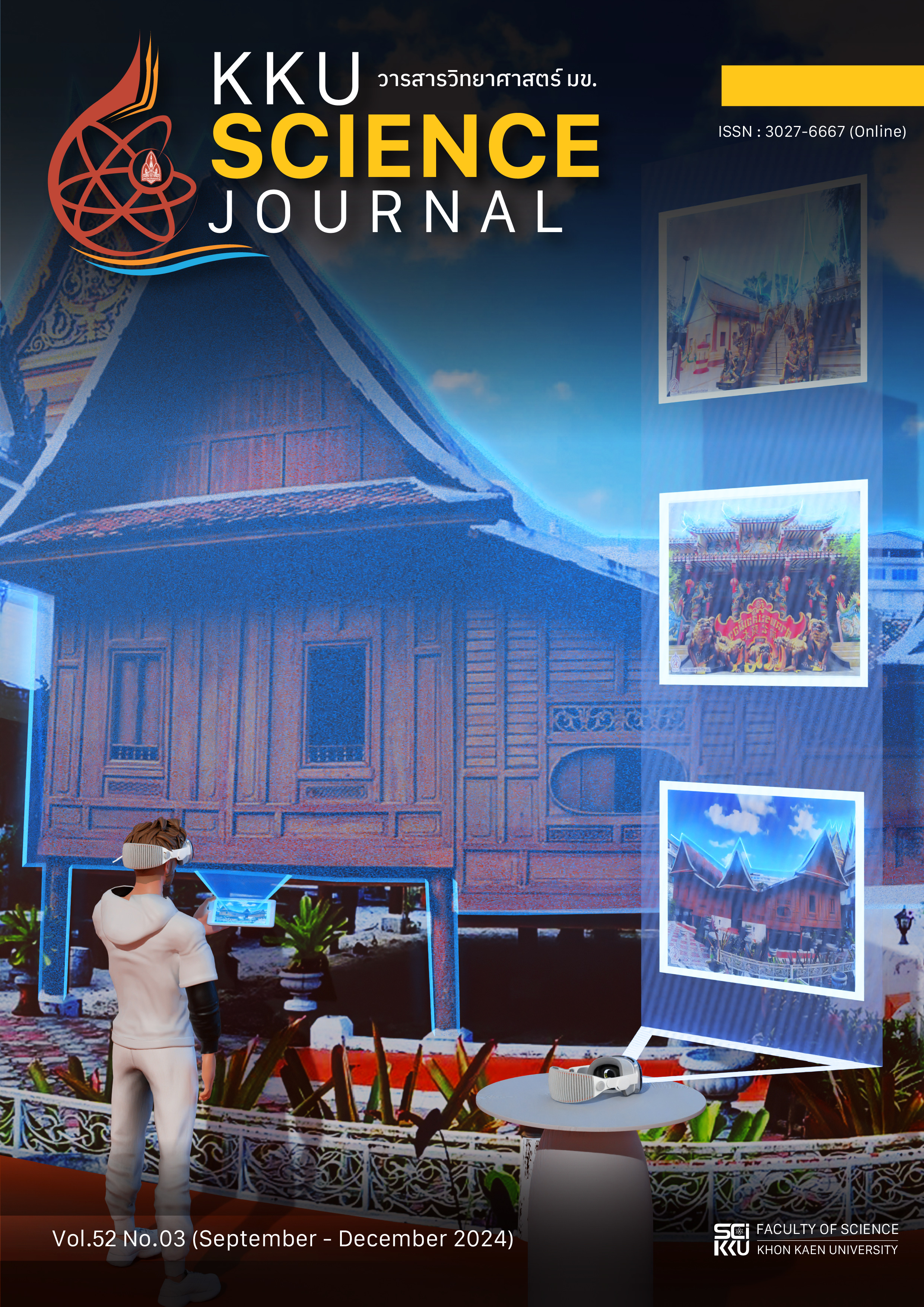Application of Geographic Information Systems to Monitor Dengue Fever Surveillance in Tha Kham Subdistrict, Panare District, Pattani Province
Main Article Content
Abstract
The objectives of this research were to 1) survey and prepare a database, 2) develop geographic information technology system, and 3) evaluate the geographic information technology system to monitoring dengue surveillance in Tha Kham sub-district, Panare District, Pattani Province. There are 5 stages of research: (1) data collection, (2) system design, (3) system development, (4) system testing and (5) system evaluation by applying the System Development Life Cycle (SDLC) as a guideline for development. This research used a convenience sampling method with 40 public health officials, village health volunteers, and local residents. The results of the research showed that: 1) survey and storage of a spatial database of the addresses of dengue patients in Tha Kham sub-district, Panare District, Pattani Province, has determined the types of data, such as names, locations, and coordinates, by collecting data from 16 field trips. 2) Results of Geographic Information Technology Development showed that the system user can collect patient data and display current location. 3) The results of the evaluation of the effectiveness of geographic information technology to monitor dengue surveillance in Tha Kham Sub-district, Panare District, Pattani Province from 3 experts found that the data storage system was highly effective ( = 4.25, S.D. = 0.50), and the results of the satisfaction assessment of 40 users showed that the respondents had a high level of satisfaction (
= 4.24, S.D. = 0.50) in all topics.
Article Details

This work is licensed under a Creative Commons Attribution-NonCommercial-NoDerivatives 4.0 International License.
References
กรมควบคุมโรค. (2563). รายงานโรคในระบบเฝ้าระวัง 506 ประจำปี 2562. แหล่งข้อมูล: http://doe.moph.go.th/surdata/506wk/y63/d37_5263.pdf. ค้นเมื่อวันที่ 10 มีนาคม 2566.
กรมควบคุมโรค. (2565). แนวทางการวินิจฉัยและรักษาโรคไข้เลือดออก. แหล่งข้อมูล: https://ddc.moph.go.th/disease_detail.php?d=44. ค้นเมื่อวันที่ 10 มีนาคม 2566.
กรมควบคุมโรค. (2566). รายงานสถานการณ์โรคไข้เลือดออก ประจำปี 2566. แหล่งข้อมูล: https://spd.moph.go.th/wp-content/uploads/2023/07/สถานการณ์และมาตรการไข้เลือดออกประเทศไทย-.pdf. ค้นเมื่อวันที่ 10 มีนาคม 2566.
กรรภิรมย์ เหล็มนุ้ย, อรยา ปรีชาพานิช, สุดา เธียรมนตรี และนิพัทธุ์ อินทอง. (2567). การพัฒนาแอปพลิเคชันความเป็นจริงเสริมเพื่อสนับสนุนการเรียนรู้พยัญชนะและคำศัพท์ภาษาอาหรับสำหรับเด็กปฐมวัย. วารสารวิทยาศาสตร์ มข. 52(1): 79 - 91.
พรสุรางค์ ราชภักดี, สีใส ยี่สุ่นแสง, ทวีศักดิ์ ทองบู่ และพุทธิพันธุ์ สนั่นนาม. (2564). การพัฒนาระบบควบคุมโรคไข้เลือดออกเขตเทศบาลวิเชียรบุรีโดยการประยุกต์ใช้แผนที่ภาษีและทะเบียนทรัพย์สินและฐานข้อมูลทะเบียนระบบสุขภาพ. วารสารวิชาการป้องกันควบคุมโรค สคร.2 พิษณุโลก 8(1): 16 - 29.
สยามราชย์ ฟูเจริญกัลยา. (2565). การพัฒนาระบบสารสนเทศในการจัดการฐานข้อมูลแผนคำของบลงทุนของหน่วยงานในสังกัดสำนักงานสาธารณสุขจังหวัดเชียงราย. เชียงรายเวชสาร 14(2): 102 - 117.
สรสินธุ์ ฉายสินสอน. (2561). แอปพลิเคชันเพื่อบูรณาการข้อมูลการท่องเที่ยวอำเภออู่ทอง จังหวัดสุพรรณบุรี โดยใช้ระบบสารสนเทศภูมิศาสตร์. วารสารเทคโนโลยีสารสนเทศและนวัตกรรม 17(2): 147 - 160.
สำนักงานสาธารณสุขจังหวัดปัตตานี. (2566). รายงานสถานการณ์โรคไข้เลือดออกจังหวัดปัตตานี ประจำปี 2565. แหล่งข้อมูล: https://ptn.moph.go.th/ptn2023/. ค้นเมื่อวันที่ 10 มีนาคม 2566.
Akter, R., Naish, S., Gatton, M., Bambrick, H., Hu, W. and Tong, S. (2019). Spatial and temporal analysis of dengue infections in Queensland, Australia: Recent trend and perspectives. PLoS ONE 14(7): e0220134. doi: 10.1371/journal.pone.0220134.
Anno, S., Tsubasa, H., Sugita, S., Yasumoto S., Lee, M.-A., Sasaki, Y. and Oyoshi, K. (2023). Challenges and implications of predicting the spatiotemporal distribution of dengue fever outbreak in Chinese Taiwan using remote sensing data and deep learning. Geo-spatial Information Science 27(4): 1155 - 1161. doi: 10.1080/10095020.2022.2144770.
Goodchild, M. F. (2009). Geographic information systems and science: Today and tomorrow. Annals of GIS 15(1): 3 - 9. doi: 10.1080/19475680903250715.
Hernández-Ávila, J.E., Rodríguez, M.-H., Santos-Luna, R., Sánchez-Castañeda, V., Román-Pérez, S., Ríos-Salgado, V.H. and Salas-Sarmiento, J.A. (2013). Nation-Wide, Web-Based, Geographic Information System for the Integrated Surveillance and Control of Dengue Fever in Mexico. PLoS ONE 8(8): e70231. doi: 10.1371/journal.pone.0070231.
Nejad, F.Y. and Varathan, K.D. (2021). Identification of significant climatic risk factors and machine learning models in dengue outbreak prediction. BMC Medical Informatics and Decision Making 21(1): 141. doi: 10.1186/s12911-021-01493-y.
Nie, B. (2015). A Study on the Second-Person Narrative in Jennifer Egan’s Black Box. Open Journal of Social Sciences 3(10): 51 – 58.
Ravichandran, A., Taylor, K. and Waterhouse, P. (2016). DevOps for Digital Leaders: Reignite Business with a Modern DevOps-Enabled Software Factory. NY: Berkeley, CA: Apress.
Scavuzzo, J.M., Trucco, F., Espinosa, M., Tauro, C.B., Abril, M., Scavuzzo, C.M. and Frery, A. C. (2018). Modeling dengue vector population using remotely sensed data and machine learning. Acta Tropica 185: 167 - 175.
Sedgwick, P.M. (2013). Convenience sampling. British Medical Journal 347: f6304. doi: 10.1136/bmj.f6304.
Sekarrini, C.E., Sumarmi, S., Bachri, S., Taryana, D. and Giofandi, E.A. (2022). The application of geographic information system for dengue epidemic in Southeast Asia: A review on trends and opportunity. Journal of Public Health Research 11(3): 1 - 6.


